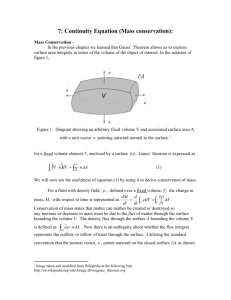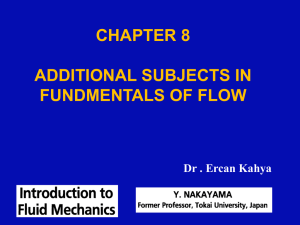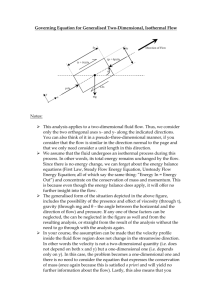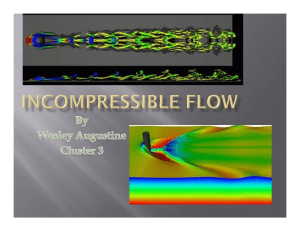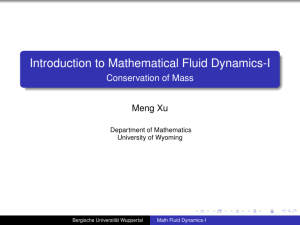4: Continuity Equation (Mass conservation):
advertisement
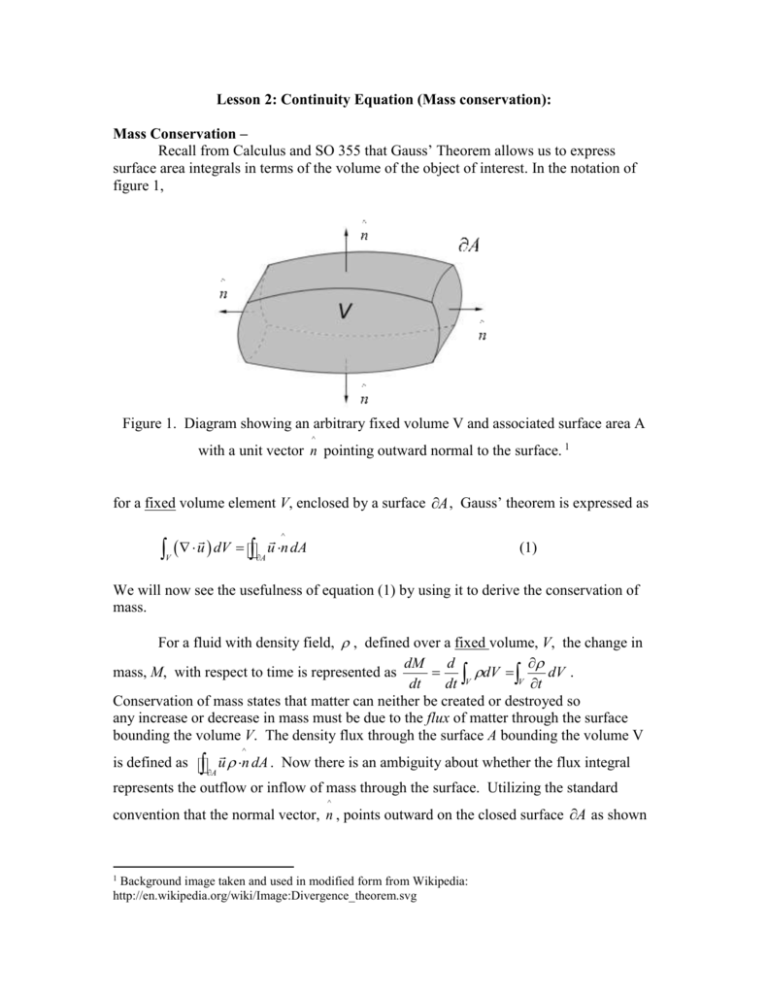
Lesson 2: Continuity Equation (Mass conservation): Mass Conservation – Recall from Calculus and SO 355 that Gauss’ Theorem allows us to express surface area integrals in terms of the volume of the object of interest. In the notation of figure 1, Figure 1. Diagram showing an arbitrary fixed volume V and associated surface area A ^ with a unit vector n pointing outward normal to the surface. 1 for a fixed volume element V, enclosed by a surface A , Gauss’ theorem is expressed as ^ V u dV A u n dA (1) We will now see the usefulness of equation (1) by using it to derive the conservation of mass. For a fluid with density field, , defined over a fixed volume, V, the change in dM d dV dV . mass, M, with respect to time is represented as V V dt dt t Conservation of mass states that matter can neither be created or destroyed so any increase or decrease in mass must be due to the flux of matter through the surface bounding the volume V. The density flux through the surface A bounding the volume V is defined as ^ A u n dA . Now there is an ambiguity about whether the flux integral represents the outflow or inflow of mass through the surface. Utilizing the standard ^ convention that the normal vector, n , points outward on the closed surface A as shown 1 Background image taken and used in modified form from Wikipedia: http://en.wikipedia.org/wiki/Image:Divergence_theorem.svg ^ in figure 1, we can see that u n dA represents the outflow of mass through the A surface. Thus conservation of mass shows us that ^ dM dV u n dA V t A dt (3) Using Gauss’ theorem, we can write the final term in equation (2) as a volume integral as ^ u n dA u dV and equation (3) can then be written as: A V dM u dV dV u dV u dV 0 V V V V dt t t The above expression for the time derivative of mass is for an arbitrary fixed volume in space and can only be possible if the integrand vanishes for every point in the domain, otherwise the equality would not hold throughout the entire domain and mass would not be conserved. Consequently, the requirement for the above integral to hold is that u 0 t (4) Equation (4) is called the continuity equation and is the differential equation form of conservation of mass. Given the definition of the material derivative of the density field D u , equation (4) can be expressed in the alternate form as as Dt t 1 D (5) u 0 Dt Showing that the fractional rate of change of the density (or volume) of a fluid element fluid is related to the divergence of the flow field. Conditions under which incompressible flow is valid: If density is constant, the fluid is said to be incompressible. Equation (4) then takes the simple form: u 0 (6) The flow field is said to be solenoidal under these circumstances. For most applications in the ocean and many in the atmosphere it is safe to assume that the fluid medium is approximately incompressible. To formally examine the necessary conditions in which it is safe to assume a medium is solenoidal; we need to perform dimensional analysis on equation (5). For a flow field scale, U which varies slightly over a length scale L, the requirement for incompressibility is 1 D U u . Dt L To gain further insight into these necessary conditions we must assume an equation of state. Now we are going to formally define the fluid as incompressible provided that the density does not depend on the pressure of the fluid medium. Thus, if we consider2, P then 1 D 1 d Dp 1 Dp 1 U u p 2 2 Dt dP Dt c Dt c L In the above we have made the assumption that the material derivative of the pressure is of the same order as the advection of pressure and we have also used a well defined thermodynamic expression that relates the variation of density with respect to pressure d 1 with the sound speed of the fluid medium as 2 . We learned in SO 335 that dp c application of Newton’s second law shows us that the acceleration of a fluid parcel is proportional to the pressure gradient so we can approximate U2 Du p ~ ~ u u L Dt And thus we can see that the requirement for incompressibility is that 1 1 U2 U u p ~ 2 2 c c L L or (7) U2 1 c2 We can see from equation (7) that most examples that we consider in the both the ocean and atmosphere allows us to use the incompressibility requirement. Incompressible fluid flow example- Vertical flow in the ocean U2 1 and a layer of depth, h, in the ocean is well mixed, we can c2 integrate over the continuity equation in the form u 0 to obtain the vertical velocity. This is extremely useful for experimental applications since vertical motions are hard to Provided that 2 This is a sloppy assumption as we know that density can depend on multiple physical parameters. For the sake of simplicity though, we only consider pressure. This is not too bad since it can be shown that the above analysis leads to the most significant or strict requirement for incompressibility. measure whereas horizontal flow is easily determined from the drift of an object over time. Splitting up equation (6) into its vertical and horizontal components: u v w z x y (8) It can easily be shown that if separation of variables is possible that the left side of the equality is a function of z and the right hand side of the equality is only a function of x and y. The only non- trivial way that this is possible is if both sides equal a constant. Integrating both sides with respect to z and applying the fundamental theorem of calculus we can see that 0 u v u v w h z dz h x y dz w0 w h x y h 0 Although there will be vertical variations on the surface with wave motion, we will assume that the average vertical velocity is 0 so w0 0 and we have an equation that relates vertical velocity in a well mixed layer with the horizontal divergence at an arbitrary depth h. We can also find the time it takes a fluid parcel to be transported Dz vertically in the fluid column by noting that w . If we consider a Lagrangian frame Dt with a fluid parcel at initial position z o , we obtain the relationship u v d z z o , t z z o , t z z o , t dt x y u v Where we have expressed the constant horizontal divergence as x y Thus the net time it takes for a fluid parcel to travel vertically between the points z z 2 z1 can be found by integrating: t2 1 dz 1 z t ln 2 z z1 z1 z2 dt t1 . (9) Assume an approximate horizontal divergence of 13.3 10 8 sec 1 , application of equation (9) shows us that, for a parcel to travel from 10 meters to 50 meters in the vertical, it would take t 1 50 sec ln 1.2 10 7 sec 140 days 8 13.3 10 10
